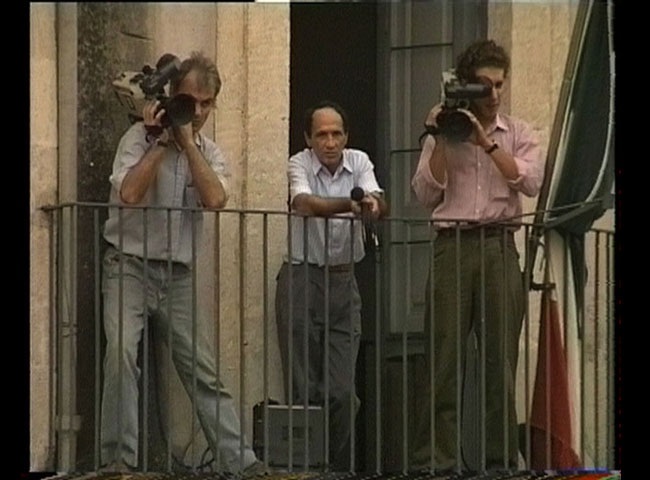Un Mito Antropologico Televiso
-
Réalisé par Maria Helene Bertino, Dario Castelli, Alessandro Gagliardo • Écrit par Maria Helene Bertino, Dario Castelli, Alessandro Gagliardo
-
Italie • 2011 • 56 minutes • S VHS • Couleur
- Réalisation :
Maria Helene Bertino, Dario Castelli, Alessandro Gagliardo - Écriture :
Maria Helene Bertino, Dario Castelli, Alessandro Gagliardo - Image :
Maria Helene Bertino, Dario Castelli, Alessandro Gagliardo - Son :
Riccardo Nicolosi - Montage :
Maria Helene Bertino, Dario Castelli, Alessandro Gagliardo
- Production (structure) :
Malastrada.Film - Ayant droit :
Malastrada.Film
- N° ISAN :
non renseigné
Résumé
"Des traces de sang au sol, une chorale d’enfants, un procès, un jeu télévisé, des manifestations, une allocution politique, etc. Le lien entre ces images ? Avoir été produites par une télévision locale de Catane, en Sicile, entre 1991 et 1994, période marquée par les assassinats en 1992 à Palerme des juges Falcone et Borsellino et précédant l’accession au pouvoir de Berlusconi.
Plus décisif encore, il y a ce que produit le montage, fait de coupes sèches et de collages imprévisibles, qui relie ces fragments selon une logique tout sauf linéaire. Ainsi réagencés, ces rushes fractionnés, provenant de scories de reportages vouées au rebut, dévoilent un double mouvement. Ils interrogent, d’abord, l’histoire de cette province et de ses habitants se constituant comme communauté à l’écart. Ils défont, ensuite, les modalités de représentation induites par le système narratif propre à la télévision, qui, on le sait, rapporte moins les événements qu’elle ne façonne notre regard. Telle est la manière dont le mythe anthropologique annoncé par le titre, est ici interrogé. Avec, supplément étonnant, une fois la part idéologique repérée, le potentiel de beauté propre à ces images, que soulignent ces moments furtifs saisis comme autant de trouées dans le fil narratif dont ils débordent. Un hommage à l’utopie toujours possible d’une télévision qui accéderait à l’évidence brute d’une pratique réellement populaire, à un moment où va basculer tout autrement l’action collective." (Nicolas Féodoroff, FIDMarseille 2012)
"What could possibly be the connection between images of blood marks on the ground, a children’s choir, a trial, a TV game, demonstrations, a political address, etc.? The answer is all of them were produced by a local television company based in Catania, Sicily, between 1991 and 1994, a time preceding Berlusconi’s rise to power, and marked by Judges Falcone and Borsellino assassinations in 1992. The editing’s sharp cuts and unpredictable collages that link all the pieces together, following an absolute non-linear logic, are even more conclusive. Thus reorganised, the split rushes, derived from scraps of news coverage bound to be discarded, reveal a double action. They first question the history of the province and its inhabitants who form an isolated community. Then, they break up the representation terms involved in conventional television narratives, which – as we know – are less concerned with reporting events than shaping our opinion.
The anthropological myth advertised in the title is thus examined through the potential for beauty involved in these images. Once the ideological part is revealed, this very potential comes up as a surprising addition, emphasised by the furtive moments that constitute numerous holes in the narrative fabric they overflow. This is a tribute to the ever possible utopia of a media world that could unveil the bare evidence of a truly popular practice, at the very moment collective action is taking a very different turn." (Nicolas Féodoroff, FIDMarseille 2012)
Mot(s)-clé(s) thématique(s)
Sélections et distinctions
- 2012 • FIDMarseille - Festival International de Cinéma de Marseille • Marseille (France) • Compétition Internationale
Comment avoir accès au film ?
-
Édition DVD
- Il n'existe pas d'édition DVD à notre connaissance
-
Accès VOD
- Il n'existe pas d'accès en VOD à notre connaissance
- Distribution
- Aide sur les moyens d'accéder à un film
